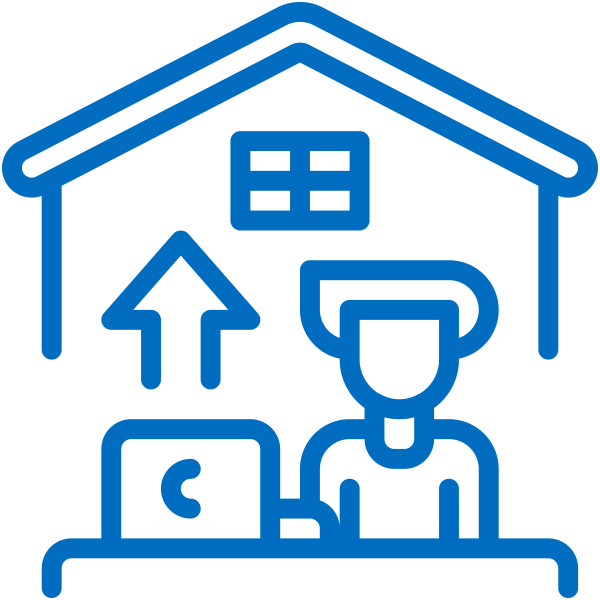Consider the Modern Workplace
And Remote Workforce Management
Until now, you, your IT team, and your trusted enterprise collaboration partner have focused their research on IT-centric activities.
At this point, you have the information you need to proceed with implementing a telecommuting program designed to align with your digital transformation strategy.
But your program participants — your management team and your employee base — play a critical role in the success or failure of your telecommuting program. Give them the training and educational resources they need to boost work from home productivity and collaboration.
In planning your Work from Home program, consider the Modern Workplace from both your management team and remote workers’ perspectives.
Your end users will have different needs based on their roles and responsibilities.
How Can I Help my Remote Workforce Management Team Successfully Adopt our Work from Home Program?
An effective change management strategy can ensure success for your telecommuting program. Consult with an IT industry expert who offers change management professional services to determine whether you’re a good candidate.
Remote workforce management presents a whole new set of challenges for a management team that is used to operating face-to-face, in-person.
As much as modern telecommuting technology facilitates remote work, anticipate an adjustment period as your management team ramps up to your new work from home environment.
During this time of transition, empower your team with guidance on best practices for managing remote employees and maximizing work from home productivity levels.
See below for tips on how you can support your remote workforce management team.
What are Some Best Practices for Managing Remote Employees?

- Establish clear communication guidelines.
- Find out how and when your remote team prefers to communicate to maximize work from home productivity. Asking for their input will enhance buy-in to whatever procedures you choose to follow.
- Make clear your expected turnaround time for email responses.
- Emphasize the importance of keeping shared calendars up-to-date.
- Similarly, keep presence indicators up-to-date to monitor availability.
- Schedule weekly standing virtual one-on-ones.
- Institute regularly scheduled checkpoint meetings on team projects.
- Encourage spontaneous “chat” to replicate water-cooler conversations. The combination of video capability and chat can be a powerful preserver of informal camaraderie in the workplace.
- Check in to ensure your team members are all educated on their enterprise collaboration tools.
- Provide educational resources for team members who need training.
- Consider emotional comfort levels. Be aware that some employees will need more guidance than others. Encourage independence but aim for a tight, team-based corporate culture.
- Keep the virtual doors open. Gather feedback on what is working for your telecommuting team? What isn’t? Test and tweak.
Monitor individual telework habits. Some employees are born telecommuters and are able to reliably focus on work despite interruptions from the home front. Others are easily distracted. Managing remote workers requires a balance between a hands-off approach and micromanaging.
Remember that your management team is adjusting to your telecommuting program as well. Provide them with similar levels of support, especially the opportunity for providing feedback. Be quick to assess and act on suggestions for managing remote employees.
Think vocation, not vacation.
Shifting from an on-site work environment to a home office might feel like freedom, but although your location has changed, your expected work hours have not.
Enjoy the freedom of working in your jammies, but have appropriate business attire handy for video conferences — at least from the waist up.
How Can I Help my Remote Employees be Successful?
Creating a remote office space that is functional and comfortable can make a dramatic difference in your telecommuting employees’ quality of life and maximize work from home productivity.
Provide your telework teams with tips on their telecommuting home office environment, their telecommuting devices, and last but definitely not least, their security protocols.
Tips for Customizing Your Home Office:
- Pick a noise-free room. Schools are closed indefinitely and you don’t want the kids playing directly above your home office. Pick a dedicated workspace that will keep you focused and productive. Keep boundaries between this space and where you relax.
- Find the right home office background. Remember, you are using video. Try to have a single-color background (save your wallpaper and artwork for some other purpose).
- Look out for windows. Windows in your home office provide difficult light if it is either behind you or to your side. Most cameras built into PCs will adjust for low light but windows create issues for light.
- Check your wi-fi signal using your phone or PC. A good test is to go into airplane mode and try making a Facetime call on your iPhone or use an app for testing your internet connection.
- For a quality video experience, check your upload and download speeds. You should have 1-4 MBPS for your internet up and down. Any less and you will have challenges. If you work in a creative industry and you are looking at high definition content-sharing or streaming, you may need as much as 5-8 MBPS. Boost your Internet through your ISP if your current speeds aren’t up to snuff.
- Check your router health. If your router is over 5 years old, now is a good time to upgrade. Newer, multi-band routers allow you to segment your wireless network into two —2.4 GHz and 5GHz — and are also good at managing wireless throughput on your home network.
- If you don’t have a new router, make sure your current router is running the newest version if its firmware, which will also address any security issues.

Check broadband speeds with your ISP. Providers are lifting broadband service caps to accommodate the increased demand due to COVID-19.
Tips for Maximizing Your
Telecommuting Devices:
- Have a dedicated work computer that is solely for telecommuting. You won’t want to be mixing personal and professional devices, and your company might not allow you to log in using a personal PC.
- Get a company-issued laptop if your personal desktop is not approved for company use. Even if it’s not a powerful device, a dock or USB hub will give you enough ports to expand your connectivity to accommodate multiple displays for multitasking.
- Buy the right monitor to support the aforementioned multitasking-enabling displays. Having the right-sized screen can have a huge impact on productivity and is easier on
the eyes. - Choose the right webcam and headset. Having the right equipment will streamline your video conferencing experience and productivity. Test run them before a call to make sure all is in working order. (It’s great to have good equipment, but if they can’t hear you, it doesn’t work. Poly and Jabra make great wireless headsets, but if you want to be simple and certain during uncertain times, get a good old-fashioned wired headset to your laptop).
- Same goes for your keyboard and mouse. Pick a combination that is designed for your type of work. Wired or wireless? Multi-device connectivity? Gamer options?
Before Your First Call…
- Be familiar with how to pick cameras and microphones on your device. This usually happens when you join the meeting. It is best to have any external mics or cameras plugged in before you access the meeting.
- Try joining your desktop client ahead of time to make sure you’re up and running by your specified meeting time. Set up a test call with a colleague and practice muting and unmuting.
- Content-sharing is always a challenge. Get on a call with a friend, share content with the app, and familiarize yourself with sharing your screen or just one window on your device. Be a native before you get on your first call so you don’t share something you didn’t intend.
Say Cheese!
Not to state the obvious, but remember – when you’re on a video call, people can see what you’re doing.
Don’t answer your email, text your friend, or get distracted by the latest TikTok video while you’re on a call. Close down all windows except the one your video conferencing app is running.
Does your company use multi-factor authentication?
Many companies are expected to trend toward implementing additional automated encrypted connections, permissions, and access reviews as a means of boosting security during this time of transition.
Tips on Ensuring Work from Home Security:
- Talk to your IT team about maximizing work from home security. Do they have approved tools in place today that you can leverage?
- This ties into the earlier recommendation to perform a complete technology audit. Your IT team will understand the nuances to getting your home office tech exactly correct. Take advantage of their knowledge and ask for help to get where you want to be.
- Are you adhering to your company’s security policies? Find out what they are and ensure you’re compliant. You don’t want to be the security weak point falls victim to malware or hackers.
- Make sure your antivirus and anti-malware applications are enabled, up-to-date, and actively monitoring your home office devices.
- Does your company use a VPN? Use it for ALL business collaboration and communication. And make sure other telecommuters have the correct privileges to use it.
- Do you know how to phish? Make sure you know how to recognize, act and report any phishing attempts.
- Repeat. Talk to your IT team. Not all telecommuting tools are equal. Some are encrypted, some are not, and some companies don’t care. Assume your company does care. Ensure your work from home security measures conforms to all workplace policies, especially any new ones that have been announced as part of your new telecommuting program.
Tips on Work/Life Balance.
- Moving work into your home can blur the lines between work life and home life. Keep distinct boundaries between the two so you can stay present in each realm.
- Remember to take breaks during the day and practice self-care. Go for a walk during the time you saved commuting. Lift your eyes from your desktop every hour to give them a rest.
- Stay connected with colleagues. Telecommuting can be isolating. Leverage today’s Modern Workplace tools that encourage instant chat and videoconferencing. Take advantage of these ways to keep close to colleagues.
- Log off all the way at the end of the day. Turn off your home office device at close of business and don’t look at it again until the next morning (barring a fastball project or pressing deadline). The temptation to check in and be “always on” can blur the distinction between work life and home life.